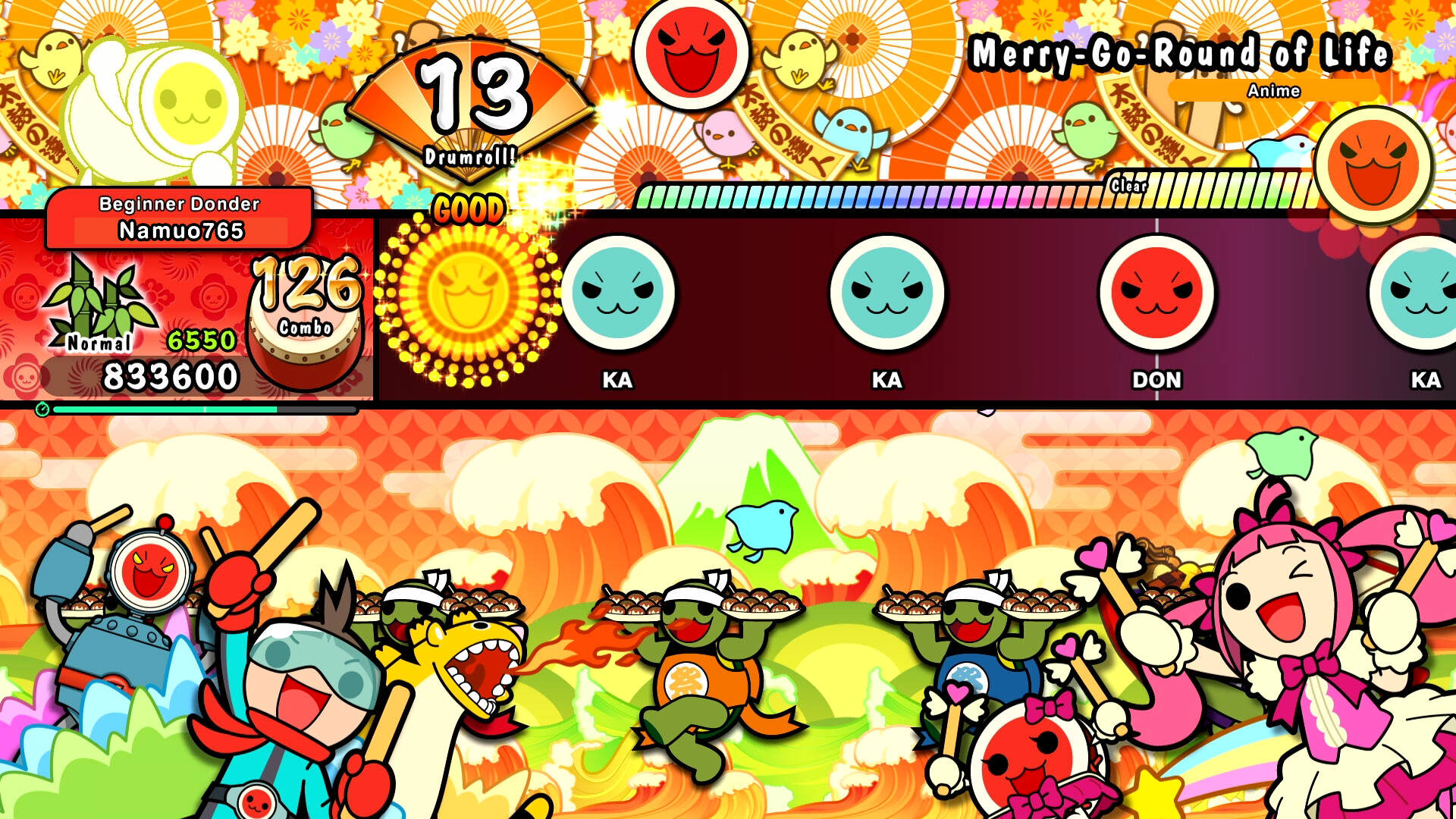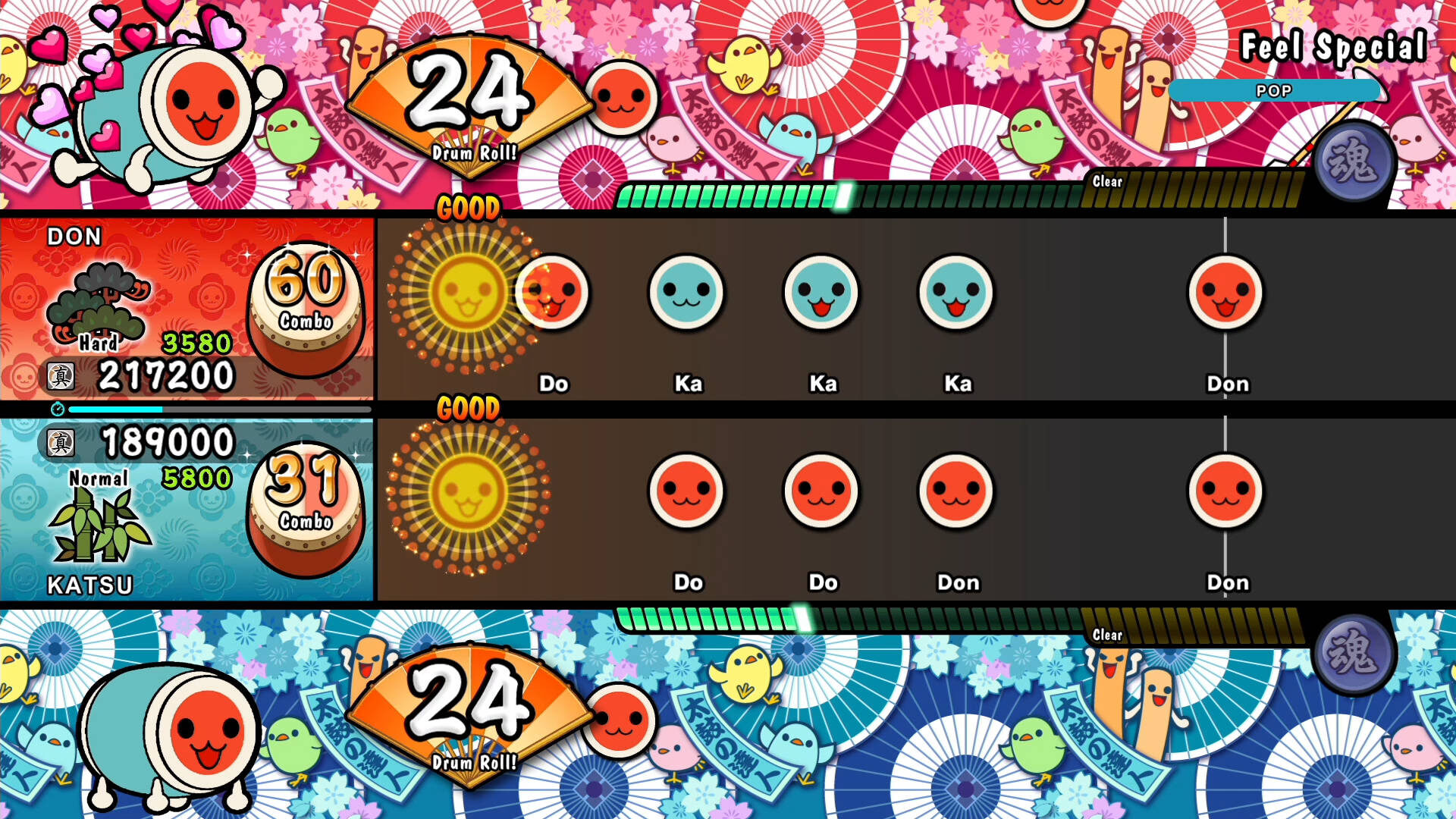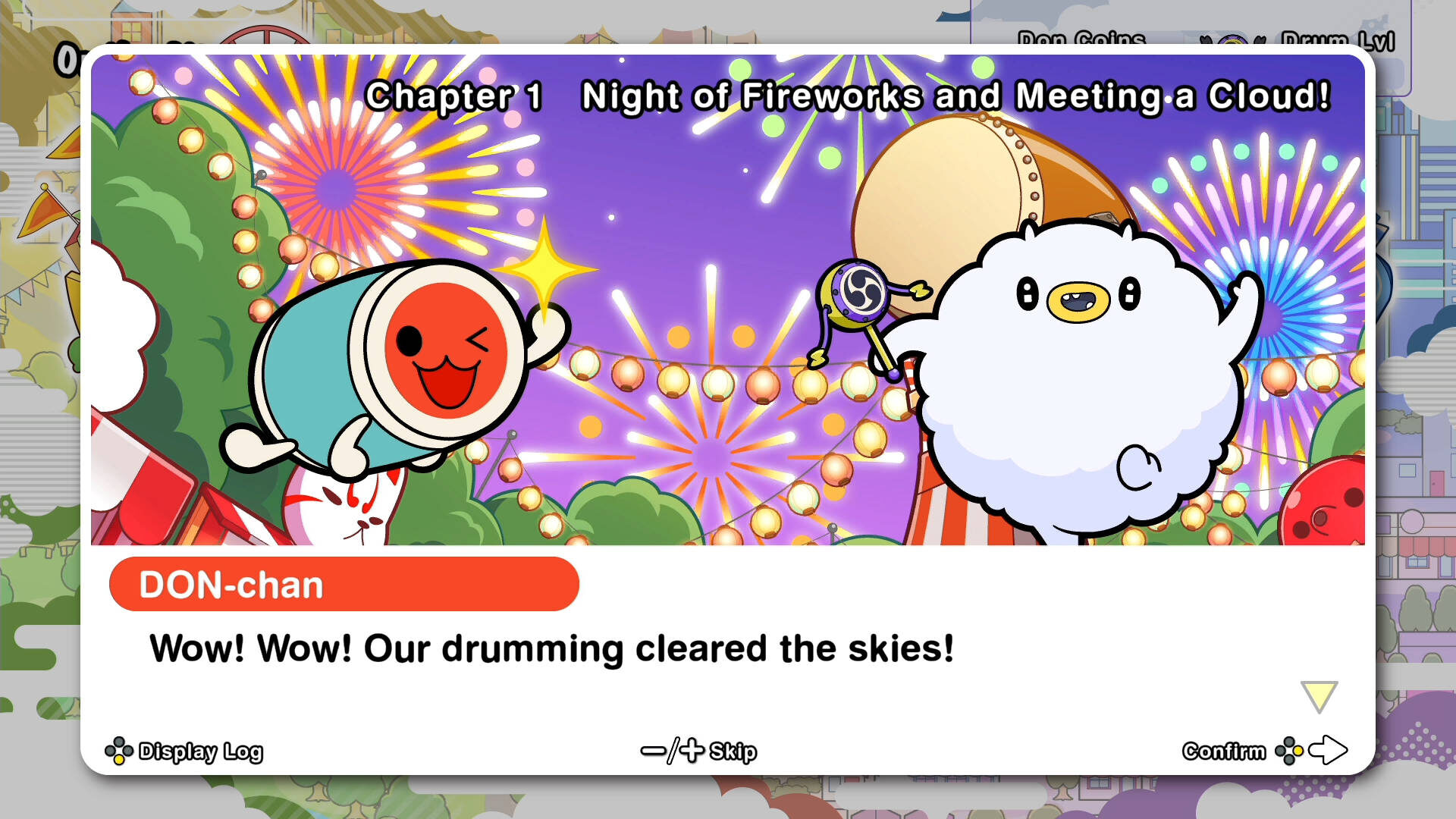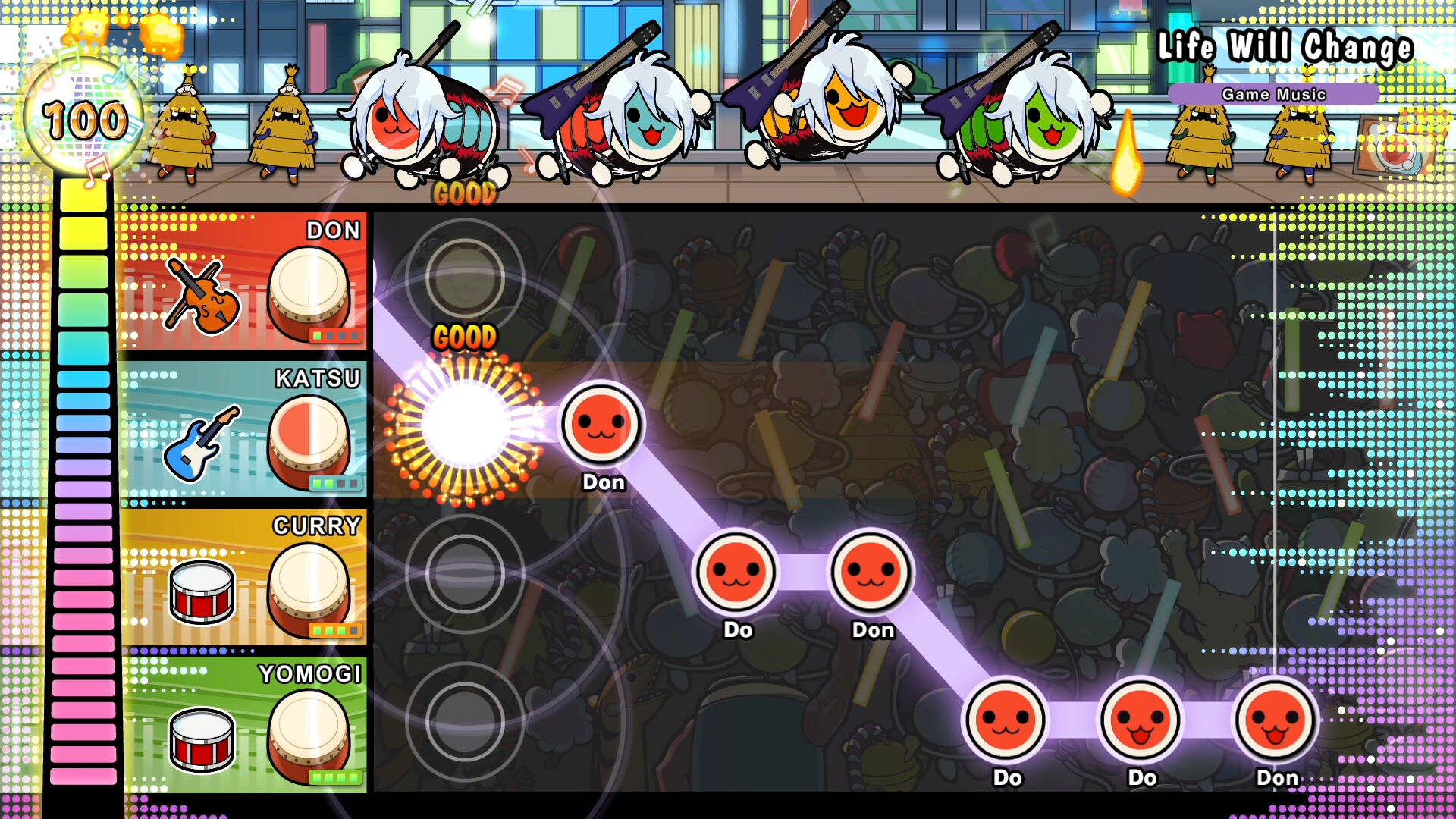I’m not sure that Bandai Namco’s Taiko no Tatsujin series has ever been an exciting part of the rhythm game genre. It doesn’t have the gaming-meets-exercise energy of Dance Dance Revolution or Pump It Up, it’s missing the “live out your dreams of being a rock star” quality of Guitar Hero or Rock Band, and it’s never really catered to the pulse-pounding score attack nature of DJ Max or Project Diva. As well, the franchise has often been somewhat inaccessible to Western players. You need a specialty controller to properly play the games—many of which haven’t even come out in the States—properly, and the entire experience is heavily based around Japanese music, both in terms of instrument and song list.
And yet, while the Taiko no Tatsujin series may not be exciting, it is comforting. As part of a genre that has seen huge evolutionary shifts in an attempt to stay relevant, the Taiko games play pretty much the same now as they did back when I was buying import copies on the PlayStation 2—and I’m okay with that. I don’t need these games to constantly be a part of my life, changing in concept and complexity as the years pass. I just want them to be there for me at those times when I want to grab some sticks and beat against a plastic drum for a while.

Like, for example, when my interest in the series flared up again recently after Bandai Namco announced that it would be bringing Hori’s official drum controllers for the Switch to America in conjunction with the English-language release of the latest game, Taiko no Tatsujin: Rhythm Festival. (Which, by the way, is out now digitally, but not due to hit physically until October 7th.)
Those controllers are important because, while Rhythm Festival or any of the Taiko no Tatsujin games are fully playable with a standard controller, or kinda playable by using the motion controls of the Joy-Cons for the Switch releases, you really should play them the proper way if possible. With two Taiko games out now on Nintendo’s current system—and an addition to Rhythm Festival that could greatly extend its lifespan that we’ll get to in a moment— Hori’s drums have become a worthwhile investment if you’re serious about the experience.
For those who might be new to the franchise, the basic idea is that those drum controllers register two kinds of hits: red don notes that you trigger by hitting the face of the drum, or blue ka notes that require a tap along the rim. As you play, both kinds of notes come onto the screen from the right side, and when they meet up with a specific marker on the left, you hit the appropriate area of the drum (or push the proper button) to trigger that note. While each type of hit registers separately on either the left or right side of the drum, they’ll still trigger the same color of note marker. The idea is that, instead of always hitting the same side, you can give your gameplay some more realistic taiko-drummin’ flair by alternating sides with each hit, while also putting less strain on one particular arm. There are then a few other types of special notes, which either require hitting both sides at the same time, or performing drumrolls to knock out a large number of notes in quick succession.

As I mentioned earlier, that core gameplay has changed little over the years, so the real question with any release is what songs it includes and what additional modes it features. Taiko no Tatsujin: Rhythm Festival initially sports around 80 tracks, which I’d consider to be a decent amount in this era. The list covers Japanese pop hits, anime theme songs, releases from the wide world of Vocaloid fandom, “Variety” tracks (which can include anything from the Pirates of the Caribbean theme to arrangements of music from Touhou Project titles), well-known classical pieces, video game music, and Namco originals.
My complaints about Rhythm Festival’s song selection are more personal grievance than actual criticism. I come to these games first and foremost for the J-pop, so to only have 10 of the included tracks cover that genre is a disappointment for me—especially when two of them, Whiteberry’s “Natsu Matsuri” (a song I love, but still) and Radwimps’ “Zenzenzense” (which I might argue should be under anime, gives its heavy connection to Your Name) were also include on the previous Switch release, Taiko no Tatsujin: Drum ’n’ Fun. Most people aren’t going to be coming to these games strictly for J-pop, though, so keeping the song list more balanced definitely helps to appeal to a wider audience.
Ah, but there’s then a huge twist to the song list in Rhythm Festival that I had no idea about until I started playing it for this review. While previous games have offered additional songs as DLC for set prices, we now get a new option called the Taiko Music Pass that adds an utterly unbelievable 583 new songs to the roster. In my younger days, the dream was always to have one home release of a rhythm game expandable to dramatic extremes versus continually buying new individual releases. Being able to add five-hundred and eighty-three new songs on top of the 80-plus we already get is a realization of that dream beyond my wildest expectations, putting Rhythm Festival in the position of being the ultimate chapter of the Taiko no Tatsujin saga for fans of the series.
Of course, all that music doesn’t come for free. Unlike previous DLC packs that were of the “pay once, play forever” sort—and there are some of those available here, to be clear—the Taiko Music Pass is a subscription service. You can purchase 30 days of access for $3.99 or 90 days for $9.99, either as a one-time charge or set to auto renewal. At first, I found the whole idea kinda gross. I hate that we’re slipping further and further into a hellish future where we subscribe to everything and own nothing. With all of the subscriptions I already have, do I really want to stress over playing a Taiko no Tatsujin game enough in a specific block of time to get my money’s worth?

The more I’ve thought about it, however, the more I think the Taiko Music Pass might actually be a good idea. With the typical cost of DLC for rhythm games, you’d be looking at hundreds of dollars to get a decent chunk of this music, and it’s very likely that a huge amount of these tracks might never have even come to the game without being part of such a service. If I or my daughters suddenly get a hankering to bang a replica taiko drum for a few hours, we can spend the cost of one DLC pack to get access to hundreds of songs for a month to get our fill.
At this point, my problems with the Pass aren’t its existence, but that I’d like to see Bandai Namco up its value. For example, we get 62 additional J-pop songs, but most of them are still covers—and I expect more from a subscription service. There is a shocking lack of Ridge Racer tracks on the game music list, and Namco originals make up 300 slots in the Pass. Look, some of them are decent, but they’re clearly there to bump up the numbers.
While music is the most important part of a music-focused game, it isn’t the only part, and Taiko no Tatsujin: Rhythm Festival brings with it some nice additions. As you play, you’ll earn not only Don Coins to unlock new customization items, but also Drum Levels to progress through a rewards map with unlockable goodies, Don Coins, and story segments. It’s not a full-fledged campaign or anything, but it’s still a nice bonus. Another welcome addition is Improvement Support, a special mode that allows you to focus on sections of songs that you’re having problems with, and practice only those parts. If this is your first Taiko no Tatsujin, then this will be a helpful tool for getting better at the game.
Over in the party game section, we get two new entries: Great Drum Toy War and Don-Chan Band. The former is a fun (but relatively simple) competitive strategy game where you put together a team of toys to fight against your opponent’s army. The better you do during a song, the more of your toys you’ll send out. Don-Chan Band, meanwhile, is a cooperative mode where up to four people work together by playing different instruments in a band while trying to complete songs. Great Drum Toy War is the better of the pair, but both are nice additions that help keep the game feeling fresh. Still, it’s hard not to miss Drum ’n’ Fun’s large variety of mini games, or its ability to host local 2-4 player sessions. Beyond all of that, there are a few different options for playing against other taiko drummers over the internet, but having spent a number of nights now getting slaughtered by players in Japan and their ungodly ability to do drumrolls, I don’t know that my ego can take playing online too much.

If you’re a fan of the series, and especially if you’re one who has picked up Hori’s Switch drum controllers, then Taiko no Tatsujin: Rhythm Festival is a no-brainer. If you’re going to only have one of the Switch releases, though, then things get a bit more complicated. I think Drum ’n’ Fun is my favorite of the two, given I like more of the songs it features, and appreciate its far more robust offerings for playing with others locally. At the same time, Rhythm Festival will be friendlier to newcomers, it has more single-player content, and the Taiko Music Pass is just so incredibly attractive if you’re looking to only invest in one game.
What’s most important is that, 20-plus years later, the Taiko no Tatsujin series remains an enjoyable, charming, and consistent series no matter which game Switch owners choose. In a world that’s endlessly changing, that’s comforting.
|
★★★★☆
Taiko no Tatsujin: Rhythm Festival is a solid new entry in Bandai Namco’s rhythm game franchise, offering a roster of fresh music to enjoy, some creative new game modes, and more unlockables to have fun collecting. The game doesn’t offer as many multiplayer options as its predecessor did, but does feature more to keep solo players occupied. Rhythm Festival also offers what is arguably the biggest addition the franchise has ever seen, the Taiko Music Pass—a new music subscription service that can greatly expand the life of the game while also bringing with it some additional concerns over our subscription-laiden future. |
Developer Bandai Namco Amusement Lab Publisher Bandai Namco ESRB E - Everyone Release Date 09.23.2022 |
| Taiko no Tatsujin: Rhythm Festival is available on Nintendo Switch. Primary version played was for Switch. Product was provided by Bandai Namco for the benefit of this coverage. EGM reviews on a scale of one to five stars. | |

Mollie got her start in games media via the crazy world of gaming fanzines, and now works at EGM with the goal of covering all of the weird Japanese and niche releases that nobody else on staff cares about. She’s active in the gaming community on a personal level, and an outspoken voice on topics such as equality in gaming, consumer rights, and good UI. Check her out on Bluesky and Mastodon.